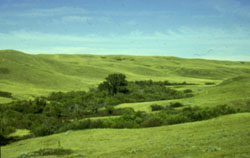| Français | Contact Us | Help | Search | Canada Site | |||||
| AAFC Online | Links | Newsroom | What's New | Site Index |
| PFRA Online | Staff | Programs & Services | Offices | ||||
Prairie Farm Rehabilitation Administration |
||||||||
|
|
||||||||
| |

Living on the Edge: Wildlife Along the StreamLife abounds in healthy riparian areas. This green transition zone poised on the edge of aquatic ecosystems and adjacent uplands, provides water, food and cover - the essentials for survival. Variation in water depth, flow rate, substrate, slope and vegetation produce diverse habitat niches which meet the needs of many mammals, birds, reptiles, fish, amphibians and invertebrates. In fact, riparian ecosystems are among the most productive and diverse ecosystems on the prairies. Streams are valuable sources of drinking water in the prairie environment. Water is also habitat or "home" for fish and other aquatic organisms. In a landscape dominated by cultivation and grassland, trees and shrubs provide valuable cover. Coulees and brush associated with riparian areas provide browse, nesting, perching, building materials and shade in the summer and protection from harsh cold and wind in the winter for all kinds of wildlife. Beaver and muskrat use poplar, willow and other woody vegetation for food and for building their lodges and dams. By modifying stream flow and creating deep slow water, they also create habitat for other organisms. Grasses and other herbaceous vegetation are used as food and cover by small mammals such as voles, mice and ground squirrels which feed on seeds, nuts and berries. Waterfowl and other birds nest is dense grass growth. Highway of the PrairiesRiparian areas are the highways of the prairies, linking larger blocks of habitat. Wooded coulees and valleys may be the only places that far-ranging cougar and bear may been seen in the cultivated prairies. Smaller animals also use riparian areas for movement. For migratory birds, riparian areas are vital refueling stops on the long journey. Aquatic and terrestrial ecosystems overlap in the green zone. Many species such as racoons feed on aquatic and terrestrial. Hawks, owls, coyotes, foxes and weasels may hunt in the uplands as well as riparian areas where prey is abundant. Many food chains are based on the small insects living in and on the water. 
Riparian areas in the prairies provide valuable travel corridors for wildlife in addition to shade and water. Healthy Streambanks Make Good FishingYou don't need to go to northern Saskatchewan to find fish. Healthy riparian areas in southern Saskatchewan are important sources of fish habitat. Northern pike, for example, use flooded grassy lowlands for spawning whereas walleye and trout prefer pebble-bottomed streams. Healthy streams have narrow deep channels with stable undercut banks and overhanging vegetation. The shade provides cover and cool oxygen rich water. Water temperature of degraded streams, which have wider channels and shallower water, is much warmer. Some species, such as trout, are very sensitive to water temperature. High temperatures can induce stress, promote disease, reduce spawning and reproductive success, slow growth and stop migrations. Healthy streams are associated with clear water. Although there is always some sediment in the water, excessive muddy water impacts negatively on many aquatic organisms. Suspended sediment blocks sunlight and reduces growth of microscopic plants and animals. Although some species of fish can tolerate sediment for limited periods, others, like trout, cannot. Gravel spawning beds may be destroyed by deposition of fine sediment. High levels of dissolved nutrients may also adversely affect fish habitat. Excessive phosphorus and nitrogen may stimulate growth of heavy blooms of algae. Microorganisms decompose the algae, and in doing so, consume oxygen. Resident fish may suffocate for lack of oxygen. Good Fishin' is Found in Healthy Riparian Areas with ...
Protecting Riparian HabitatProtecting riparian habitat begins by understanding the habitat requirements of resident insects, fish, birds and wildlife. When managing for fish habitat it is important that riparian vegetation remain intact and the streambank remain stable. This means that if grazing is occurring, livestock should be managed to prevent excessive vegetation removal and bank collapse. Where the riparian area has been cultivated, buffer strips of perennial vegetation may be established. To be effective in intercepting nutrients, and reducing erosion, buffer strips should be at least 10 metres wide. Ideally, buffer strips more than 30 metres wide and planted to perennial grasses, shrubs and trees. 
Good livestock & land management goes hand in hand with good riparian and wildlife habitat management. Controlling livestock access to riparian areas by developing rotational grazing systems, gravel bottomed watering sites or alternative watering systems away from riparian areas enhances water quality and streambank stability. Grazing intensity and timing should be managed to leave sufficient carryover to provide cover for waterfowl nesting and forage and browse for wildlife. Livestock exclusion from critical areas may be required for a period of years in severely degraded situations. A cottage owner can protect fish habitat by allowing vegetation to grow in shallow water, leaving rocks and gravel along the shoreline and avoiding construction of docks and boathouses where they increase sedimentation. Culverts and ditches associated with access roads should not block fish migration.
We gratefully acknowledge the support of the following funding partners of the Streambank
Stewardship Program. The Saskatchewan Watershed Authority and its partners in the Streambank Stewardship Program have developed a planning guide to help landowners develop their own stewardship plans. The planning guide is available from the web site above. |
|||||||
|
||||||||